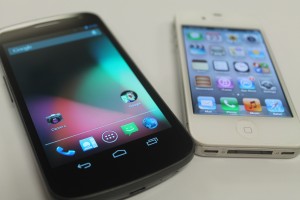by Ernad Suljic; Chief Web Administrator

“I can’t wait! Only one month, twelve days, and sixteen hours.” Birthday? No, but to some people, this probably means more. What can it possibly be, you ask? Why, it’s phone upgrade time! In this day and age of smartphones, there are really only two viable choices. The Apple or the Alien. iPhone or Android. These two types of mobile phones make up a total of 85% of the global market share, with Android’s 68% and iPhone’s 17%, according to a report published by Dubai based research firm IDM. Both phones have recently undergone major changes to improve functionality, but which one is truly better for the average high school student? Read on.
Review Subjects
For the purpose of this review, the two specific mobile phones we will be comparing will be the Apple iPhone 4S running iOS 5.1.1 and the Samsung Galaxy Nexus running Android 4.1.1 (Jellybean). Both phones are the elite flagship for each operating system and they both run the latest version of their respective OS’s.
Capabilities
Smartphones can do just about anything a computer can:browse the web, send e-mail, watch YouTube, listen to music, download applications and even take photos. This holds true for both phones. Although the iPhone is a very worthy competitor, Android and the Samsung Galaxy Nexus simply outdo the iPhone with a host of Android-Only features such as Near Field Communication, which allows the phone to be used in place of a credit card, face unlock, and the ability to edit the appearance of your home screen and applications. For students it just makes the phone more fun and it allows it to be more personalized.
User Friendliness
iPhones are notorious for their easiness to use as well as how easy it to set most things up. Their menus require very few steps and they are very self-explanatory. The Galaxy Nexus and other Android phones are a bit more complex and are geared more towards people who have experience with smartphones and know what they are doing. Furthermore, the iPhone’s applications all appear on the home screen, which can be reached with the simple press of the home button (the only button), so they require very little searching compared to Android. The iPhone easily wins in this category and will not take you long to master, which is a huge plus for some.
Voice Assistants
Have you ever been so lazy that you couldn’t even get up to set your alarm clock? We all probably have at one point or another. Now, in iOS 5.1 and Android 4.1, users don’t even need to bother to open the clock application to set it either. Just open Siri or GoogleNow and tell it what time you’d like the alarm to ring. Both phones will do it for you, no questions asked. Although Siri is the older software, GoogleNow triumphs over it. The responses it provides are much faster and much more accurate, which is due in part to Google’s new voice recognition engine. GoogleNow can even tell you how the Cardinals game ended yesterday, and when the Cardinals play next. This saves many keystrokes and just makes the smartphone experience more intuitive on an Android.
Camera
People now rarely carry their cameras with them 24/7. For capturing life’s greatest moments, people are dependant on their smartphones. Without a shadow of a doubt, the iPhone 4S has one of the most advanced cameras in the smartphone world. The 8 megapixel shooter is better than even some digital cameras and there is yet to be an Android phone which can truly compare to the iPhone. The Galaxy Nexus and Android in general do have more feature-heavy photo editing software, and a more intuitive photo-taking interface, but the raw quality of images and video easily goes to the iPhone. This phone will allow you to capture professional-quality shots no matter where you are.
Internal Hardware
Nobody can argue that a Ferrari is beautiful on the outside, but, remember, it wouldn’t be able to reach 200mph+ if it didn’t have the engine that it does. In order for these two phones to scream power, their internals must be the crème de la crème. The iPhone uses an 800MHz Dual-Core Apple A5 processor while the Galaxy Nexus packs a 1.2GHz Dual-Core TI chip. What this means is that the Galaxy Nexus has a 50% higher raw output than the iPhone 4S. The Galaxy Nexus also contains twice the RAM (memory used to multitask) than the iPhone, with 1GB and 512MB respectively. The majority of high-end Android phones follow this trend, so Android dominates in this category, giving you ability to get things done 50% faster, while also being to handle numerous applications and processes at once.
Screen
When the iPhone 4S was released, the term “Retina Display” was something that seemed unbelievable. A screen whose pixels were undistinguishable with the naked eye. But is it really something unique, or more of a gimmick? The iPhone 4S features a 3.5 inch LCD screen with a resolution of 960×640 pixels (326 pixels per inch). Meanwhile, the Galaxy Nexus uses a 4.65 inch screen with a laptop-esque resolution of 1280×720 pixels (316 pixels per inch). The iPhone’s PPI is 3% better than the Galaxy Nexus’, but it’s an unnoticeable figure in everyday use. Because screen size is dependent on the individual person, the tiebreaker in this category will be the contrast ratio. What this basically tells is how large the difference is in luminescence between the darkest color a phone can produce, black, and the lightest, white. The iPhone 4S LCD screen only has the capability to pull off a ratio of 800:1. This figure pales in comparison to the Samsung’s 100,000:1 ratio produced by its LED display. The Galaxy Nexus once again wins this category for Android and will provide you with a brighter, more vibrant screen which also happens to be HD.
Overall
No matter your preferences, you can’t really go wrong with either phone. Although the iPhone is more friendly to use and has a better camera, Android’s capabilities, voice assistant software, hardware and screen give it the title of the best smartphone for the average high school user.





